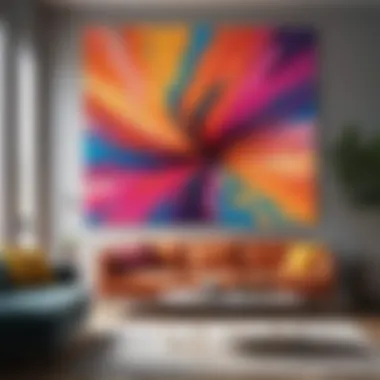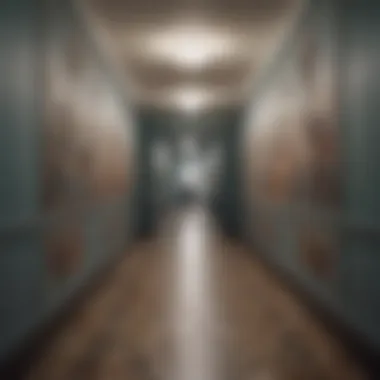Enhancing Interiors with Wall Paintings in Home Decor


Intro
In the world of home decor, the role of wall paintings often transcends mere aesthetic appeal. They have the power to transform a space, giving voice to personal style and enhancing the overall vibe of an interior. With an array of styles, techniques, and cultural influences, wall paintings serve as both a canvas for artistic expression and a tool for mood-setting in any environment.
Wall art can range from elaborate murals to simple framed prints, each bringing its own distinct character. The act of selecting the right artwork involves thoughtful consideration of various factors. These include color schemes, themes, and how they harmonize with existing decor. Understanding the impact of wall paintings goes beyond choosing something visually pleasing; it is about curating an atmosphere that resonates with one's personality and lifestyle.
As we delve further into this subject, it’s crucial to recognize the various trends that shape wall art today. Additionally, exploring effective placement strategies can lead to a cohesive design aesthetic that may elevate a room from ordinary to extraordinary.
Moreover, knowing how to maintain these artworks ensures their longevity, allowing them to continue enhancing your space for years to come. By examining these elements, readers can gain insight into the multifaceted world of wall paintings, equipping themselves with the skills needed to enhance their interiors effectively.
Understanding Wall Paintings
The journey into the realm of interior decoration takes a vital turn when one ponders the significance of wall paintings. These artistic expressions do more than just adorn our spaces; they breathe life into our interiors, offering a glimpse of personality and style. Wall paintings serve as a medium through which we communicate feelings, aspirations, and individuality. In homes where every detail counts, understanding wall paintings enriches not only the aesthetic appeal but also creates an environment that resonates with those who dwell within.
Wall art is more than decorations hanging on the wall. It is meticulously curated, chosen to reflect personal beliefs or to invoke a certain emotion in the onlooker. The art we choose has the power to influence the atmosphere of a room. For instance, bright and whimsical pieces might evoke cheerfulness, while darker tones can offer a sense of calm or contemplation. Here’s why understanding wall paintings is crucial:
- Personal Connection: The right piece can speak volumes about who you are, sparking conversation and connection.
- Mood Enhancement: Art can significantly affect the mood of a space. A painting can turn an ordinary room into a sanctuary of joy, creativity, or tranquility.
- Cultural Reflection: Wall paintings can reflect societal context, giving insight into the aesthetic values of different cultures.
Gaining an understanding of wall paintings is a fundamental step towards achieving a cohesive and appealing home environment.
The Concept of Wall Art
Wall art encapsulates a range of creative expressions that embellish the surfaces of our homes. This can include murals to small canvases, each bearing a specific story or feeling. Important aspects to consider in this concept include how these artworks relate to movement, texture, and choice of medium. The interplay of colors in a piece can set the emotional tone for an entire room, and the decision to incorporate wall art can heavily influence the functionality and overall ambience of the space.
Historical Context
Ancient Civilizations
Ancient civilizations offer a treasure trove of inspiration regarding wall art. From the intricate frescoes in Pompeii to the hieroglyphics of ancient Egypt, these artworks were often infused with cultural significance and status. These pieces of art not only served decorative purposes but were also functional, summarizing complex narratives or spiritual beliefs within the confines of a dwelling. The key characteristic here is the storytelling element, something that remains relevant in modern homes. These themes can inspire home dwellers to seek art that enlightens their own stories, making pieces from ancient cultures an attractive choice for contemporary interiors. Unique features like the use of natural pigments highlight the advantages of durability and an organic appeal, which modern homeowners may find intriguing.
Renaissance Influences
The Renaissance brought with it an artistic rebirth that forever changed the landscape of wall art. Artists like Leonardo da Vinci and Michelangelo used wall spaces to create magnificent works that filled viewers with awe. This period is well-known for its emphasis on perspective and human emotion, adding layers of depth to the art. Such characteristics are vital for creating inviting spaces today; the emotional capacity of Renaissance works serves as a beneficial aspect when decorating homes. Furthermore, the use of vibrant colors and natural motifs continues to entice homeowners, connecting them to an illustrious past while providing a timeless elegance in their decor.
Modern Movements
Modern movements diverge widely from historical precedents, embracing new styles and mediums. Abstract art challenges traditional form and opens up unlimited possibilities for interpretation. This diversity in style can cater to various tastes and preferences, making modern art a popular choice for contemporary interiors. The unique feature of modern movements lies in their ability to provoke thought and debate, allowing one to experience personal or collective histories through art. However, understanding modern movements also involves recognizing the potential disadvantages, such as the polarizing nature of abstract pieces which might not complement every interior style. Ultimately, the contribution of modern art to wall decorations provides a dynamic dialogue within spaces, engaging viewers in fresh conversations.
Types of Wall Paintings
When it comes to home decoration, wall paintings serve not only as an aesthetic enhancement but are also a reflection of personal identity. Understanding the different types of wall paintings available can help one make informed decisions that align with their style and the overall theme of their space. In this section, we will explore various forms of wall paintings, each with its unique characteristics, benefits, and considerations.
Mural Paintings
Characteristics
Mural paintings have stood the test of time. These large-scale artworks often cover expansive areas and can tell a story or create a notable ambiance in a room. One key characteristic of murals is their ability to transform spaces dramatically. Whether it’s an enchanting forest scene or a modern abstract design, murals can captivate the imagination. Their scale offers a sense of depth and perspective that smaller artworks may lack, making them a popular choice for those looking to make a bold statement in their interior.
A unique feature of murals is also their adaptability; they can be designed specifically for the contours of a wall, making them effectively tailored to their environment. However, potential drawbacks include the permanence of the artwork; altering or removing a mural can require significant effort and cost.
Application Techniques
When it comes to applying murals, there are several techniques, such as painting directly onto the wall or using removable wallpaper. Each method presents its own sets of advantages and challenges. A popular technique is fresco, where pigments are applied onto wet plaster, allowing the colors to bond with the wall itself. This leads to vibrant coloration, though the skill required for such techniques can be high.
Another accessible option involves using stencils or projectors to guide the placement of designs. These methods make it simpler for a homeowner to achieve professional-looking results without enduring the risk of freehand painting errors. The most significant consideration is the required skill level for different techniques, as some demand a professional hand, while others are amicable for do-it-yourself enthusiasts.
Abstract Art
Interpretation
Abstract art can provoke thought and emotional responses, even without direct representation of reality. The key characteristic here is its openness to interpretation; viewers often bring their experiences to the artwork. This type of art adds a layer of complexity to a room’s décor, allowing for deeper engagement with the space. One reason it’s celebrated is its capacity to foster a conversation – the more abstract, the more varied the interpretations.
Abstract art can, however, be polarizing. While some find profound beauty and meaning in its forms and colors, others may regard it as lacking clarity. Understanding the kind of emotional resonance you seek from art can help navigate these complexities.


Color Schemes
Color schemes in abstract art can dramatically influence the atmosphere of a room. A vibrant palette might invigorate a space, while muted tones can create tranquility. The selection of colors, much like a culinary dish, must balance contrasting ingredients to achieve harmony.
Choosing artwork that complements existing décor is vital; it provides an opportunity to tie in various elements – think textiles, structural features, or furniture colors. One drawback of abstract art may arise if the color scheme feels dissonant, leading to a jarring rather than cohesive visual experience.
Landscape and Nature Themes
Landscape and nature-themed wall paintings invite the tranquility of the outdoors into the home. They can range from sweeping mountain vistas to delicate floral imagery. These types of paintings are often associated with relaxation and can bring a sense of peace to living environments.
Placed prominently, such artworks can become focal points or quieter accents depending on size and style. Their versatility means they can adorn everything from spacious living rooms to intimate bedroom corners, although they often work best in areas where viewers can reflect quietly.
Portrait and Human Figures
Emotional Impact
Portraits and paintings featuring human figures can evoke strong emotional responses. They carry a narrative, lending the room a sense of warmth and familiarity. A striking portrait can create a connection, profoundly impacting the viewer’s mood and experience within a space.
The emotional weight these pieces carry can be both a draw and a pitfall. Viewers may feel a strong attachment to specific subjects, leading to personal resonance, or conversely, disconnect if the portrayal does not resonate with their sensibilities.
Placement Considerations
When it comes to placement, portraits benefit from strategic positioning to maximize their emotional impact. High traffic areas like living rooms invite conversations around such art, while private spaces like bedrooms might host more introspective pieces. The height of installation also plays a role; traditionally, portraits captivate more when hung around eye level. This accessibility allows viewers to connect deeply with the artwork. However, care must be taken to avoid placing them in areas where potential damage could occur, like above furniture where accidents may happen.
Selecting the Right Wall Painting
Choosing the perfect wall painting can have a massive influence on the overall vibe of your home. It’s not just about slapping a piece of art on the wall; it’s like telling a story through visual elements that reflect your personality. The right painting can tie a room together, evoke emotions, and create a certain atmosphere that fits the intentions of each space. Here’s where we can delve into specifics—your personal style, the functionality of each room, and how your chosen colors work in harmony with everything else.
Personal Style and Preference
Defining Your Aesthetic
When we talk about defining your aesthetic, we’re getting to the crux of what makes a space uniquely yours. This is about understanding what resonates with you—factors like your favorite colors, themes, or even textures that draw you in. Everyone has a distinct taste, whether it is cozy and rustic or sleek and modern.
Key Characteristics: Finding your aesthetic can turn the daunting task of home decorating into a fulfilling journey. It’s beneficial because it leads to an authentic representation of who you are, giving visitors a glimpse into your life without saying a word.
One unique feature of establishing your aesthetic is its flexibility. Unlike a pre-defined trend, it allows for personal twists and adjustments over time. The only downside? Sometimes, being true to your preferred style can clash with current trends, creating a tension between personal satisfaction and social acceptance.
Influence of Trends
Trends are like the ebb and flow of the ocean, constantly changing yet shaping the way we decorate our spaces. While trends can dictate what’s hot and what’s not, incorporating them into your home should still allow for individuality. Following trends can introduce fresh ideas and a modern flair to your walls.
Key Characteristic: Trends provide inspiration that helps keep your walls looking current and lively. It’s a popular choice because it can easily elevate the aesthetics of your home, making it feel fresh and appealing.
However, one unique aspect is that trends can sometimes feel fleeting. If you lean too heavily into what’s trendy, you might find yourself wanting to change things up sooner than you’d like, which can lead to additional expenses.
Room Functionality
Choosing Art for Living Spaces
Art in a living space goes beyond mere decoration; it sets the tone for interaction and relaxation. Choosing the right piece can spark conversation among guests or provide a calming atmosphere for family. This is especially important in areas designed for gathering.
Key Characteristics: Pieces that are vibrant and engaging can set the stage in a communal area, creating a welcoming environment. For a living space, choosing art that speaks to you while encouraging connection is an opportunity for a personal touch.
The downside may arise if the art chosen doesn’t mesh well with the room’s dynamics, making it feel out of place. Finding balance is crucial here.
Considerations for Private Areas
When it comes to spaces designed for privacy, such as bedrooms or bathrooms, the art you choose should evoke comfort and tranquility. It’s not just about aesthetics here; it’s about enhancing your personal retreat.
Key Characteristic: Choosing serene and introspective pieces can help to create that calming oasis, fostering relaxation and reflection. These spaces should feel uniquely personal, making this choice all the more critical.
The unique feature of art in private areas is its intimate nature. You can select art that resonates with you on a deeper emotional level. However, be cautious—what you find calming may not have the same effect on guests, which could lead to a disconnect in shared spaces.
Color Coordination


Color coordination is perhaps one of the most vital aspects of selecting wall paintings. The right color palette can enhance a room’s atmosphere effectively. Consider how colors evoke emotions, create depth, or even highlight specific areas of interest in a room.
In this process, it’s essential to think about the dominant colors already present in the room. It’s not just about choosing colors that complement each other, but also understanding how they interact with the furniture, lighting, and overall design scheme.
This attention to detail ensures that your wall painting integrates seamlessly into the existing decor, becoming an enhancement rather than a distraction.
Placement Strategies
Placement strategies for wall paintings serve as critical guidelines in ensuring that art not only enhances aesthetics but also melds seamlessly with the overall design of a space. The manner in which art is arranged can fundamentally affect the ambiance, making it crucial to consider several factors such as the size of the room, furniture layout, and the existing color palettes. Choosing the best placement can amplify the impact of the artwork and positively influence the mood and functionality of the area.
Gallery Walls
Creating Symmetry
Creating symmetry in gallery walls is one of the most visually appealing strategies in interior design. Symmetrical arrangements foster a sense of balance and harmony, which can be reassuring in a chaotic world. A well-thought-out symmetrical display can turn a blank wall into an eye-catching centerpiece. Key characteristics include the alignment of frames either horizontally or vertically, which can create a uniform look. This approach is popular because it appeals to our innate desire for order.
The unique feature of symmetry lies in its ability to simplify complex spaces. While generally a safe design choice, it does have limitations. Rigid adherence to symmetry may feel stifling or boring in an already structured environment. Thus, it's often prudent to introduce slight asymmetries in different elements, such as size or frame styles, to keep the viewer's interest alive.
Mixing Sizes and Frames
Mixing sizes and frames offers an invigorating option for gallery walls. This approach cultivates an eclectic feel by breaking away from the expected uniform look. By integrating different frame styles—be it rustic wood, sleek metal, or ornate designs—the arrangement gains texture and character. The beauty of this method is that it allows each piece to shine while still forming a cohesive narrative.
A key characteristic of mixing sizes is its ability to draw the eye across the wall, inviting exploration. When well-executed, it creates an engaging visual rhythm that captivates viewers. However, it’s essential to be cautious; without a guiding principle—like a common color or theme—this strategy can appear chaotic. The challenge lies in ensuring that the variety enhances rather than detracts from the overall aesthetic.
Focal Points
Emphasizing Structure
Emphasizing structure through wall paintings can dramatically alter the perception of an interior space. Incorporating art that highlights architectural elements, such as columns or alcoves, can enhance the existing features of a room. Key to this strategy is understanding the layout; for instance, a large mural above a fireplace can act as a dramatic focal point that draws attention upon entering the space.
The strength of emphasizing structure lies in its utility—it integrates art naturally into the environment rather than forcing it. However, the downside might be that it could overshadow the subtlety of smaller artworks or decorations, creating an imbalance in the room's atmosphere.
Directing Attention
Directing attention through chosen wall art is a strategic technique that can be employed to navigate the observer’s gaze. Art positioned at eye-level captures immediate focus, while larger pieces or brighter colors can draw attention to specific zones. This characteristic is critical, particularly in areas where interaction takes place, like living rooms or dining areas, enhancing the flow of movement and conversation.
Although directing attention can imbue a space with energy and life, over-reliance on this method could create visual distractions, making it hard for the viewer to appreciate the overall ambiance. Finding that balance between highlighted pieces and harmonious spacing is paramount to ensuring that the room's character is intact.
High and Low Heights
Considerations for Tall Ceilings
For spaces with tall ceilings, approaching art placement differently becomes necessary. Important considerations include selecting elongated or oversized pieces that command attention. The sense of grandeur that high ceilings provide is effectively balanced by large-scale artwork or multiple pieces arranged vertically.
A key characteristic of this strategy is its ability to establish a visual connection between the ceiling and the ground, promoting a feeling of cohesion. Nonetheless, care is needed; too much height can lead to a sense of disconnect if not executed thoughtfully. Hence, ensuring pieces are well-positioned and carefully chosen is essential.
Art on Lower Walls
Art on lower walls can create intimate spaces that feel inviting. This strategic placement invites close engagement and can transform areas traditionally seen as less important into focal points themselves. Key characteristics include smaller pieces or installations that promote viewer interaction. Art like sculptures, or framed works in lower positions can encourage guests to examine details up-close.
The unique feature of lower wall art is its ability to make a room feel cozier—an advantage in large or cavernous spaces. However, it does come with drawbacks; these pieces may be hidden behind furniture or other objects, thereby losing visibility and impact.
Maintaining Wall Paintings
Maintaining wall paintings is essential for keeping their aesthetic and cultural value intact over time. Similar to how one cares for a living plant, wall art demands attention to ensure its longevity and continued impact on the space. From cleaning techniques to light control, understanding how to maintain these artworks will ensure they remain vibrant and integral to your home's decor.
Cleaning Techniques
Safe Materials
Using safe materials for cleaning wall paintings is not just common sense; it's essential. Many individuals overlook how harmful some standard cleaning supplies can be to delicate surfaces. Safe materials typically include non-toxic cleaners that won't strip away the paint or alter the color. As these products are gentle, they protect the artwork while effectively removing dust or grime. Certain options, like distilled water with a little mild soap, ensure cautious handling without jeopardizing the painting's integrity.
Unique to safe materials is their eco-friendliness. This characteristic contributes significantly to preserving not only your artworks but also the environment. While traditional cleaners might quickly eliminate dirt, they often carry risks of chemical damage. Choosing safer alternatives promotes sustainability and showcases an awareness of green practices, both of which resonate with today's mindful consumers.


Frequency of Cleaning
The frequency of cleaning wall paintings often gets lost in the shuffle of home upkeep. Depending on environmental factors, such as dust or the presence of pets, the right interval for cleaning can vary significantly. Regular cleaning serves as a preventive measure, warding off tougher dirt accumulations that could lead to permanent damage.
Key characteristics like adaptability come into play here—adjusting your cleaning timeline according to the room’s activity can be beneficial. For instance, artworks in high-traffic areas might require monthly attention, while those in more static spaces can be cleaned every few months. This unique feature of tailored care provides both flexibility and protection, responding to the specific needs of your paintings.
Protection from Damage
Light and Humidity Control
Managing light and humidity is indispensable for protecting wall paintings. Certain artworks, especially those on paper or made from organic materials, are particularly vulnerable to fading or warping under excessive light exposure or dampness. The solution often lies in maintaining gentle levels of both, ensuring your wall art remains as stunning as the day it was hung.
In climate control contexts, using UV-filtering glass or adjustable window treatments adds a layer of safeguarding that many overlook. This characteristic benefits the artwork, minimizing risks related to discoloration and mildew. Furthermore, understanding how humidity fluctuates in different seasons allows for timely adjustments using dehumidifiers or humidifiers as appropriate.
Climate Considerations
Not all climates are created equal when it comes to safeguarding wall paintings; this aspect is crucial to consider. In regions with high humidity or extreme temperature shifts, the risks of damage consequently increase. Understanding your home's environment is paramount for making informed choices regarding art placement and protection efforts.
Climate considerations emphasize the significance of selecting suitable artworks for your locale. While some pieces may thrive in warm, cozy settings, others may be best suited for cooler climates. This thoughtful approach not only preserves your art but also enriches your living spaces, allowing personalization that resonates with your home’s atmosphere.
Effective maintenance empowers your wall paintings to contribute meaningfully to your living spaces, reflecting your style while standing the test of time.
By taking these multifaceted elements into account, homeowners can enjoy the beauty of their wall paintings while ensuring these artistic expressions remain cherished parts of their interior decor.
Contemporary Trends in Wall Art
In today’s world, wall art is more than just embellishment; it’s a reflection of personal identity and cultural currents. Emphasizing contemporary trends in wall paintings offers insights into how modern art can influence home environments, providing functional beauty alongside aesthetic appeal. With evolving technologies and interests, the landscape of wall art expands, making it essential to stay attuned to these shifts. Not only can these trends enhance the visual dynamics of a space, but they also introduce a higher level of engagement and conversation around interior decoration.
Digital Artworks
Digital artworks have carved out a significant niche in the realm of interior design. Unlike traditional methods, the production of digital art is often more accessible and allows for an impressive range of styles and effects.
Many interior designers and art enthusiasts are embracing the flexibility that digital pieces offer. Here’s why:
- Customizability: Digital art can easily be altered to fit specific spaces or color schemes. Want that stunning piece in teal instead of blue? No problem.
- Limited Editions: Artists can produce multiple editions without diminishing the original's integrity, making unique pieces more attainable.
- Technological Engagment: With advances like augmented reality, you can visualize how a piece fits in your space before making a commitment.
Digital artwork can invigorate a space, bringing in modern concepts while allowing for easy updates as trends change. That’s like having your cake and eating it too - you get to stay fresh without committing to one style!
Sustainable and Eco-Friendly Paints
As awareness of environmental issues climbs, the art world is also adapting. Sustainable and eco-friendly paint options are gaining traction among artists and homeowners. The benefits here go beyond aesthetics to embrace the notion of responsible decoration.
- Health Consciousness: Traditional paints often release volatile organic compounds (VOCs) harmful to indoor air quality. Eco-friendly paints, on the other hand, prioritize health and decluttering spaces.
- Sourcing: Many sustainable options are now made from natural materials, emphasizing a return to local traditions while minimizing carbon footprints.
- Aesthetic Appeal: These paints often provide beautiful finishes, blending earthy tones and textures that can add depth and warmth to interiors.
Furthermore, opting for eco-friendly options isn’t just about responsibility; it’s also about being part of a broader narrative around sustainability. It’s as if each brushstroke contributes to a story that resonates with the guardians of future generations.
"Wall art is a window into cultural sentiment – today, more than ever, it reflects not just style but also ethical values."
With the integration of digital artistry and sustainable practices, the contemporary wall painting scene invites a broader understanding of aesthetics. Embracing these trends enriches our interiors, keeping them innovative and responsible. It’s about marrying high-quality visuals with conscientious living—a combo that caters to the discerning taste of modern homeowners.
Cultural Influences
Cultural influences play a pivotal role in the realm of wall painting. In many ways, wall art serves as a mirror, reflecting the beliefs, traditions, and aesthetics of different societies. Each culture brings its unique flavor, transforming spaces in ways that resonate with the personality and heritage of the inhabitants. By understanding the cultural influences on wall paintings, we can appreciate how these artworks can enhance home decor, enriching not just the aesthetics but also the narrative behind a space.
Global Styles
Asian Inspirations
Asian inspirations in wall paintings are rich with history and symbolism. Many styles, like traditional Japanese ink paintings or Chinese brush strokes, embody serenity and nature, inviting a sense of calm into a home. One of the key characteristics of Asian art is its connection to nature, reflected in themes of landscapes, flora, and fauna. This makes it a beneficial choice for individuals looking to create a peaceful haven within their home.
The unique feature of Asian wall art lies in its emphasis on spirituality and balance. These elements contribute to a harmonious living space. However, one must consider the potential disadvantage of cultural mismatch; not every style within the Asian spectrum may resonate with all personal aesthetics.
European Artistic Traditions
Meanwhile, European artistic traditions boast a vast array of styles, from the grandeur of Baroque to the subtlety of Impressionism. One significant aspect of European wall paintings is the emotional depth captured within each piece. The key characteristic of these traditions often revolves around the interplay of light and color, which can dramatically alter the ambiance of a room, making it a popular choice for those looking to add sophistication and historical depth to their decor.
A common unique feature is the rich thematic diversity, which ranges from classical mythology to pastoral scenes. This can create an impressive conversational piece within a space. Nevertheless, these rich and often ornate styles can sometimes overwhelm a simpler decor scheme. Therefore, careful selection is needed to ensure the artwork complements rather than clashes with the overall design.
Cultural Expression Through Art
Cultural expression through art is an essential aspect of enhancing home interiors. It showcases personal identity, interests, and stories that shape one’s living environment. Wall paintings are not just decorative; they are intimate expressions of who we are and where we come from. The narratives embedded in these artworks can significantly impact the aesthetic appeal of a home, making it feel more personalized and meaningful.















